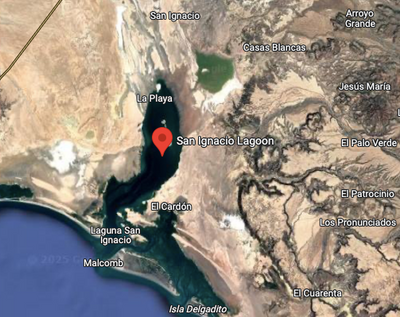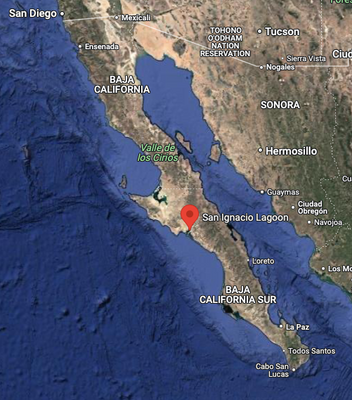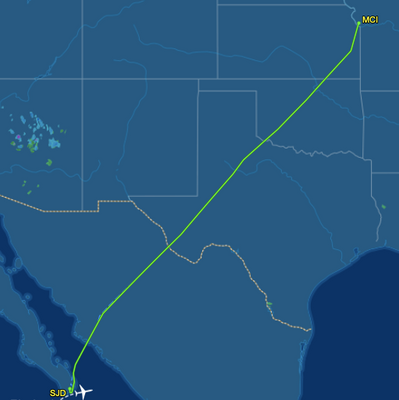Chapter 29: Fly to Cabo San Lucas 2/15/25
Beginning the Final Whale Chapters
Rather than Paul Whale Watching, here it is to be Whales Paul Watching. The North Pacific Gray Whales in San Ignacio Lagoon, Baja California Sur, are said to be perhaps even more curious about people than are people about them. I have come to the Baja to see if that is true.
Today I take the nifty Southwest Airlines 1818, the wonderful just-under-four-hour non-stop flight from Kansas City to San Jose del Cabo (SJD) in preparation for these final chapters of my "Year of Whales" saga. I expect this to be the icing on the cake. We will see. Today is just for travel and a property inspection which I will describe at the end of this entry.
First, however, to whale commentary.
Gray whales do not feed in these warm waters. Their feeding behavior was completed weeks ago--more than 4,000 miles north of here. Now, mothers, having just given birth and seemingly proud, are reported to eagerly show off their newborn calves so we humans can “Oooh and Aaaah” over them much as we humans do for each other’s newborns. Other females are here to be courted by anxious males so that they can become pregnant and return after their 12-month gestation period to give birth. Curious and possibly even bored, these 60,000 pound 45-foot long sea mammals (technically cetaceans) migrate annually from the Arctic to the San Ignacio Lagoon to congregate, mate or give birth to and ultimately display their offspring. It is said to be awe inspiring, emotional and in a strange way intimate. That all sounded to me like something I could not pass up.
As point of fact, my advance research indicates that these creatures are said to be not only curious about boats and humans, they are said to be able to perceive and feel at a high enough level to explore, learn about their surroundings, pass that knowledge along to offspring and remember.
Here halfway down the Baja, geography has created the San Ignacio Lagoon which reaches sixteen miles into the desert while spanning five miles of breadth. The water here is “coastal brackish” with intertidal flats along its banks. The lagoon is divided into three sections that run from the Pacific Ocean inland. The lower lagoon is for whale socializing and mating, the shallow upper lagoon is the birthing area (far from threatening predators--ORCA, the beautiful but deadly Killer Whales) while the middle section serves primarily as a travel route for mothers and newborns to reach the open ocean.
For both them and me, timing is everything. Early arriving gray whales begin to show up in late December. That would be too early for my quest. By early February, pregnant females are giving birth. And from Mid-February until late March, it is a melee of mothers and calves. And, this year, in mid-February, the perfect time for me.
Why come here after having three distinct whale encounters within the past several months? Because here, rather than me--the curious human seeking out interaction with whales, it is said to be curious whales and calves voluntarily seeking out contact with human beings of which I, gentle reader, am undoubtedly one.
How did this alleged phenomenon come to be? The well documented story is this: Francisco Mayoral—known to most everyone as Pachico—was fishing here in 1972. Pachico made his subsistence living in this way and was on the water every day to support his family. One day, a whale surfaced and lingered by his boat. Most fishermen here were rightly afraid of these giants. In years past the whales had been hunted, chased, harpooned and ultimately slaughtered--nearly to extinction. Whaling, however, was greatly restricted before it was too late. The whales, however, knew that humans were killers and were, therefore, aggressive in defense of their lives and the lives of their offspring.
They would attack--if you have read Moby Dick, Mr. Melville has covered that topic exhaustively and in extremis.
Pachico, however was a curious man and, against what some would say was better judgement, lingered. This particular whale came closer. Perhaps it was too young to have experienced the horrific behavior of mankind, or maybe its mother failed to teach it to watch out or maybe it was simply a risk taker. In any event, Pachico, showing no fear, calmly put his hand in the water. The whale rubbed against it. Remarkably, the whale lingered. On that day, a rapprochement between the species began. That behavior has since replicated and expanded, culminating on Monday with me becoming Pachico if even for only three days. (Sadly, Pacheco died on 10/22/23 a year and a half ago, at the age of 72) Whether or not the whales mourned will remain unknown.
Fortunately, a mad rush of destructive tourists has not commenced, thanks to protective local residents and the responsive Mexican Government.
Today, this amazing interactive experience is tightly regulated and taxed. A specific visitation zone has been set up and operates under strict rules. Only sixteen small fishing boats—here called pangas—are allowed on the lagoon at a time. They must leave after 45 minutes with the whales. Motors must be turned off when whales approach and of course, operators are not allowed to chase, pursue or otherwise approach the whales. The whales operate under their own rules and may behave as they wish. If they decide to approach the pangas and their human occupants, no amount of government bureaucracy will stop them.
Regulations, however, are critical. These waters are clearly the most important place on our planet for the North Pacific Gray Whales to reproduce. The depth, temperature, nutrient status and salinity of the water mix to make this both the unique red light district and maternity ward for these once endangered giants while simultaneously offering them vital protection from predators.
The whales, while stars of the show, are not alone. These waters teem with harbour seals, California sea lions, northern elephant-seals and even some blue whales. Four of the seven species of endangered marine turtles—leatherbacks, hawkbills, greens and olive ridleys—also come here to lay their eggs year after year after year.
I am anxious to make my way from here in Cabo San Lucas up the peninsula to the lagoon--a journey I will begin early Monday morning.
But first, tonight I stay at VRBO Property: 2327260, Unit ID: 2893556 for two nights. My Host is Lara Bishop. She is the owner of a pizza place, Jo's Garden, that I have driven by countless times while here in Cabo San Lucas and have always wanted to try but haven't. Now I shall. Real estate is the cause of my coming down here two days prior to my whaling adventure.
After my arrival in Cabo this morning, I made a visit to our "condo under construction" at Alvar inside Pueblo Bonito Sunset Beach. While I cannot be certain, it appears to me that there has been very minimal to no progress since we were here just before Christmas. Originally the property was to be ready for us to occupy in April--just two months from now. Six months ago they extended that anticipated completion date until November of this year. From the looks of things, they may not make that promised date either.
Sad to say, fans of B4's commentary on these blog entries will be disappointed. She, being the Big Business woman that she is, will be engaging in work on her various Boards of Directors. In truth, it is that work that gives me the opportunity, without fear of abandoning or aggravating her, to engage in these adventures. So, thank you corporate America. Your demands upon her time emancipate me to enjoy various guilt-free pursuits. So, on this day-after-Valentines Day, I am once again off. (That sentence can be read in a multitude of ways if one gives it ample consideration)
And, for what it is worth:she would not have enjoyed the spartan accommodation I have engaged for these first two nights of this journey.






